Harrison is going away, but part of the old hospital will live on -- here's how
The former Harrison Hospital building in Bremerton is finally being torn down. But it won't completely disappear -- at least, not the distinctive yellow sandstone blocks that have made up its exterior for decades.
Bremerton's Mick Hersey, who has worked on veterans memorials and volunteers to maintain cemeteries around Kitsap, found a unique way to repurpose a small part of the building, in the process honoring the hospital's founders, Benjamin and Angie Harrison, and Kitsap's military history.
As the work to demolish the nearly 60-year-old building on Cherry Avenue got underway this summer, Hersey, a 68-year-old Bremerton veteran known for restoring veteran memorials for over a decade, stopped by the site to ask if he could take some sandstone blocks. He wanted to build a flower planter in front of the Harrisons' tomb at Ivy Green Cemetery, on Bremerton's west side.
The construction company said yes.
So Hersey drove his pickup and moved eight loads of blocks from the hospital to his carport. Currently, about 100 pieces of sandstone blocks are stored at his house. He's chipped off the cement mortar on the blocks so they may be evenly stacked, and even collected five buckets of cement mortar that may be used as backfill later.
"So it's all going to be reused, instead of just throwing it to the dump," said Hersey, who is also a volunteer coordinator of the Ivy Green Cemetery. Hersey retired from the Navy as a senior chief cook in 1997.
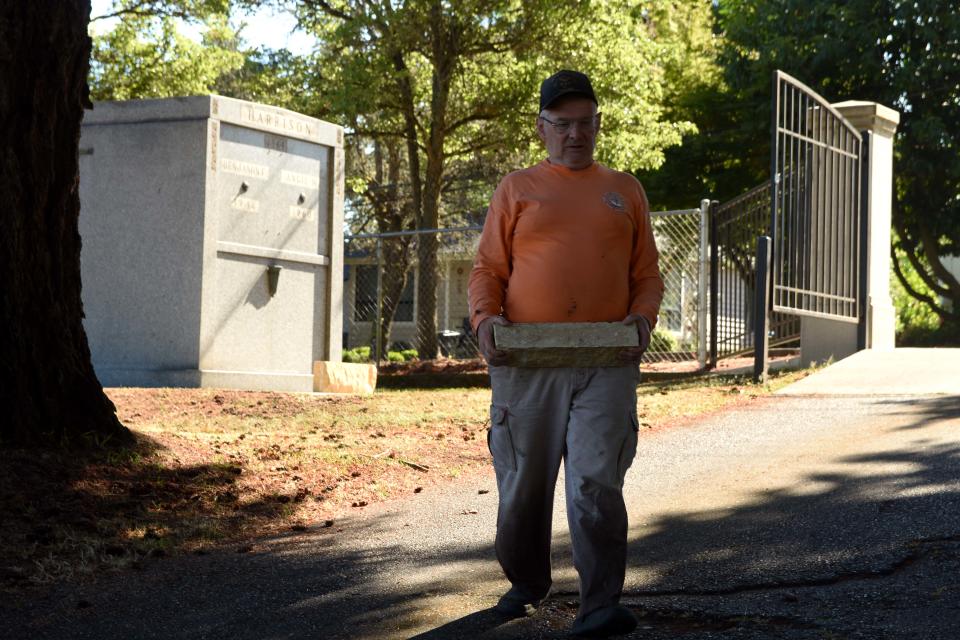
"The Harrisons were one of the original founders of the town," Hersey said, mentioning their role as primary shareholders of the hospital. "That's, to me, a way to honor them with a piece of their actual hospital."
The construction company, Seattle-based Howard S. Wright, was honored to send the blocks, the company said in a statement.
"When Mick Hersey reached out to us for help repairing headstones at a local cemetery, we were honored to donate salvaged bricks from our project to support his efforts in preserving the memory of loved ones," a spokesperson for Howard S. Wright said.
"As a business that employs many military veterans, supporting Mick's efforts at the cemetery was a natural decision for us," the constructor said.
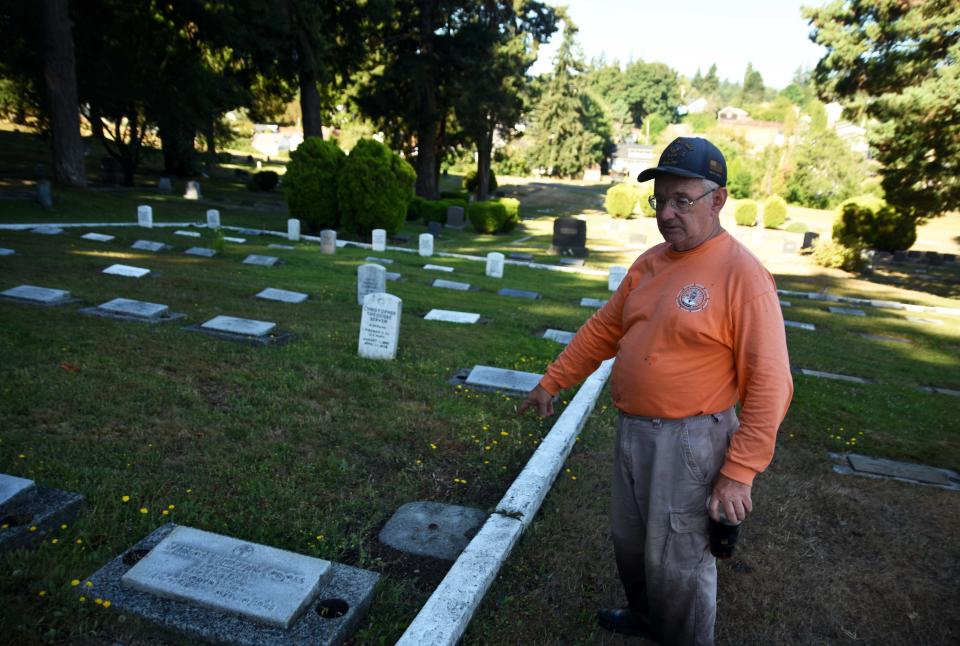
From hospital walls to flower planters in Bremerton
Hersey also plans to rebuild six 12-inch-wide square flower boxes at the veteran section of Ivy Green. The original round cement flower pots and two in the line with the flagpole are aging, and couldn't be restored. The pots were believed to be built during World War II, so they could be almost 80 years old, Hersey said.
Hersey will need 70 more sandstone blocks from the hospital to complete these missions, he said.
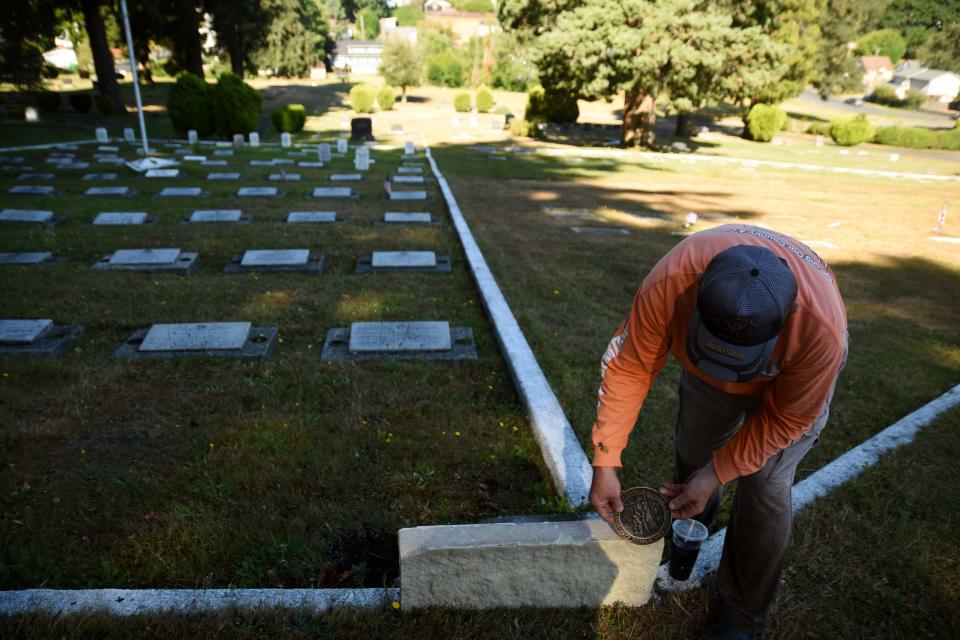
A rectangle, 32-inch-long, 12-inch-wide and 14-inch-high flower planter will be built in front of the grave of Angie and Benjamin Harrison to honor them, Hersey said.
Angie Harrison was a nurse at the First Methodist Church in Bremerton when a makeshift hospital was organized there in 1918, following the global influenza epidemic. A new hospital opened in downtown Bremerton that year, and Angie and Benjamin, a hardware store owner, became its majority shareholders. The hospital was initially called City General Hospital. It became Olympic Hospital in 1931, Harrison Memorial Hospital in 1942, and opened a campus on Cherry Avenue in East Bremerton in 1965, according to Kitsap Sun archives.
In 2005, Harrison Memorial was renamed Harrison Medical Center. An affiliation agreement was approved between Harrison Medical Center and CHI Franciscan Health of Tacoma in 2013 and the hospital was moved to Silverdale in 2020 under the new name St. Michael Medical Center. The Cherry Avenue building has been vacant since then.
Hersey plans to finish building the flower planters in September. But the story, and the continuing use of Harrison's façade, won't just end in Bremerton.
From the archives: Hospital consolidation and history collide: How Harrison Medical Center lost its name
A second cemetery, in Seabeck, benefits from Harrison
Hersey recognized an opportunity to use the sandstone blocks to honor veterans there as well.
In Seabeck, Hersey wants to use the blocks to mark about 140 unnamed burial sites. About 178 to 200 people were buried in the 1.25-acre cemetery owned by the Seabeck Conference Center, but only about 60 graves were marked, said Candace Kolbas, co-chair of the Seabeck Cemetery Restoration Project and a chapter registrar of Elizabeth Ellington Chapter, National Society Daughters of the American Revolution, which organizes and fundraises the restoration project to fix damaged graves in Seabeck starting in 2023. That includes removing the salal and wild shrubs at the cemetery to find the graves.
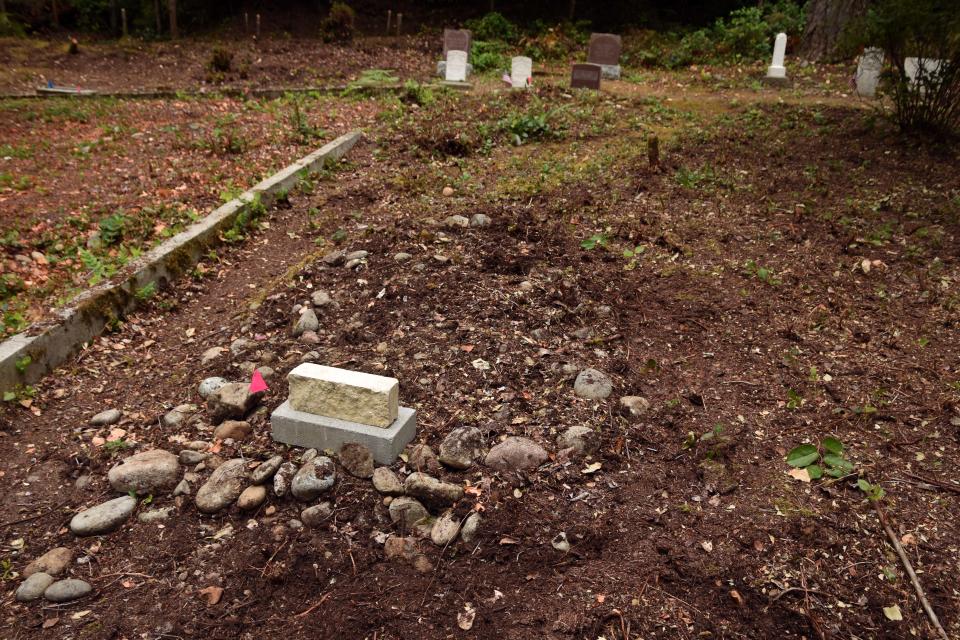
Hersey's idea of reusing the hospital blocks became part of the project.
"We're going to cut them 12 inches long, put them on a cement base, and that'll mark everywhere that we know an unknown person is buried," Hersey said.
Daughters of the American Revolution (DAR) is a D.C.-based nonprofit organization consisting of women at or over 18 who can prove lineal, bloodline descent from an ancestor who aided in achieving American independence. Elizabeth Ellington is its local chapter located in the Silverdale-Bremerton area that has about 116 members in the Kitsap region and beyond, according to Kolbas, who is joined by co-chair Amy Brooks.
Angie Harrison was a DAR member and the regent of the Elizabeth Ellington local chapter from 1933 to 1935, so that's another reason why using the former hospital's blocks to mark the unknown graves is meaningful, Kolbas said.
"She (Angie Harrison) was such a philanthropist," Kolbas said. "She and her husband Benjamin were such philanthropists and gave back to the community so much. I think she'd be tickled pink to know that the stone from the hospital is being used to mark all the unknowns in our cemetery."
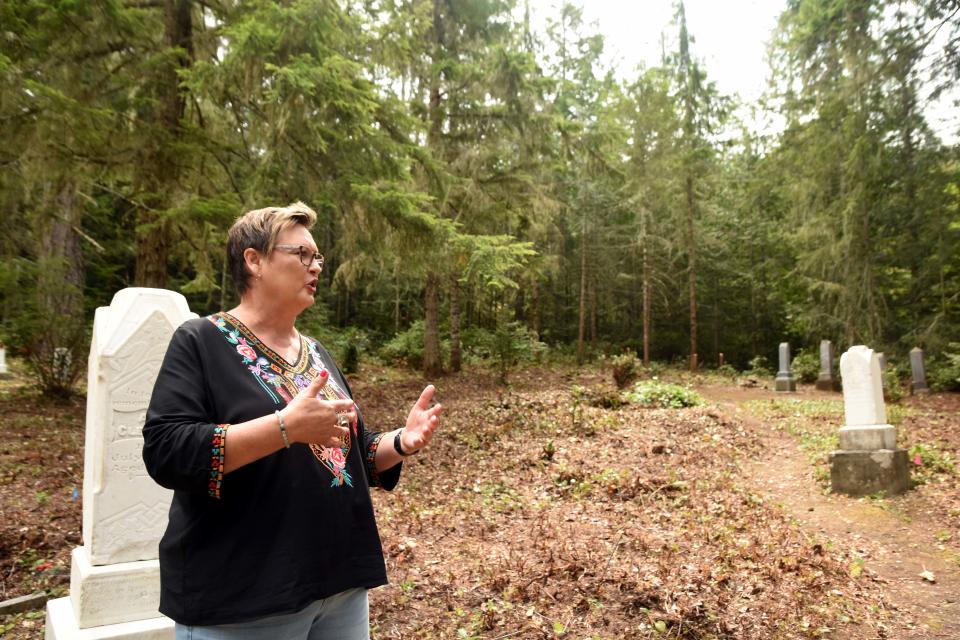
Seabeck project links to country's 250th birthday in 2026
Kolbas said the project to clean up and recover Seabeck Cemetery, located north of Dancing Deer Way, started in 2023. As part of the nationwide American 250 Project, the DAR's local chapters were asked to find ways to identify and honor a Revolutionary War Patriot in each state to celebrate America’s 250th birthday in 2026. That year will be the 250th anniversary of the signing of the Declaration of Independence in 1776.
According to the Veterans Museum at Balboa Park in San Diego, approximately 25,000 to 70,000 American patriots died during active military service. Among them, about 6,800 were killed in battle and at least 17,000 died from disease. Most of those killed by disease died while being kept as prisoners of war of the British and mostly in the prison ships in New York Harbor.
Since there are no Revolutionary War Patriots buried in Washington State — at that time the area was part of the Oregon Territory — the chapter decided to find and honor Civil War veterans who may have ancestors who participated in the Revolutionary War.
And, the organization found a few of them in the Seabeck Cemetery, which was established in 1860 and now belongs to the Seabeck Conference Center.
Volunteers from the local DAR chapter, as well as those from Navy Hospital, Bangor, Washington Military Academy, Geocache Club, John Paul Jones chapter of the Sons of the American Revolution (SAR), and students at Central Kitsap High School, helped. Over 1,000 volunteer hours were given to the project to clean up the cemetery and identify potential graves between March and October last year, Kolbas said.
In June 2023, the organization contacted Suzanne Elshult, an experienced K9 handler, founder of the nonprofit Cascadia Search Dogs and president of Cairn Canine Detection for assistance. Elshult has been helping the DAR find the exact sites of the unknown burials since then. "Unknown" means the burials are documented in historical records but no graves with recognizable headstones are observed at the cemetery.
Another input came from Dan Miller, a carver at The Tenino Stone Carvers, who is recreating damaged graves and recover their original design, according to Kolbas.
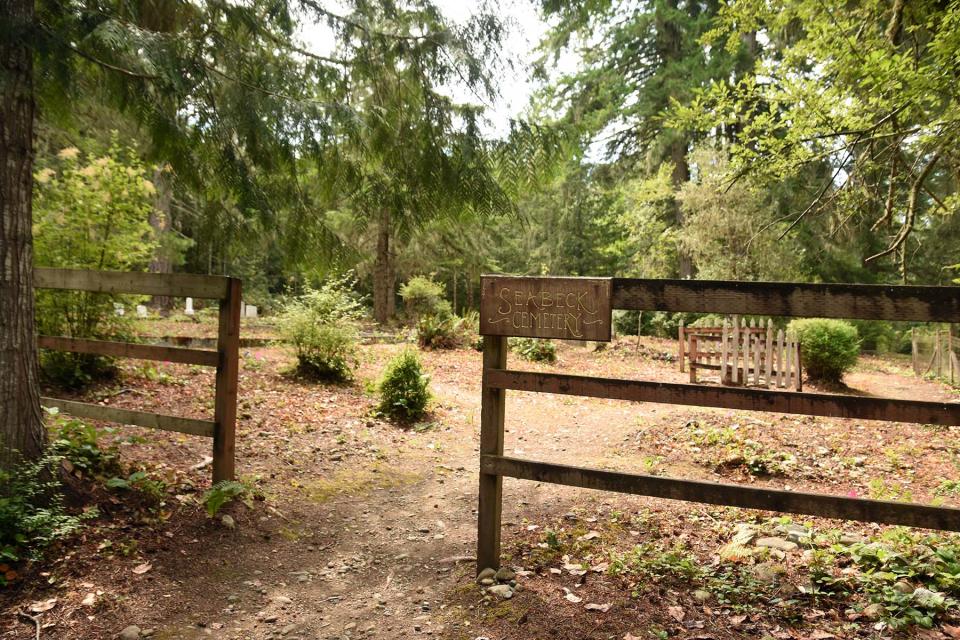
Preserving local history for future generations
The ultimate goal is to preserve the historical landmark for future generations, keep the stories of those buried alive, and to tell the history, Kolbas said.
"We just want to honor the cemetery and respect it and tell its story and preserve it," said Kolbas, adding that most of the people buried at the Seabeck Cemetery worked at the two lumber mills in Seabeck, so "their history is part of Washington State history."
More: Could Seabeck have been Seattle? Eagle Scout resurfaces history of once booming mill town
As part of the restoration, DAR plans to put signage in the Myrl Thompson gazebo, located at the center of the Seabeck Cemetery with a map and names to identify the location of the graves. A QR code will be provided there so that people can scan to read the stories of those buried, Kolbas said.
The restoration project is expected to be completed by June 2025, Kolbas said.
The local DAR chapter is fundraising for the project through various channels and events, including a GoFundMe page. The restoration of the graves requires lots of money, Kolbas said.
"Just for the GPR (Ground Penetrating Radar), we need to raise $18,000 for each. And we have about four sandstone bases that we will eventually replace. Those [on average] are about $4,000 each, depending on the size," Kolbas said.
Descendants of Revolutionary War, Mayflower rest in Seabeck
The DAR local chapter members documented some of the stories of those buried in Seabeck, including descendants of Revolutionary War patriots and a Mayflower passenger.
William J. Russell (1862-1938) and Martha (York) Russell (1864-1940) were buried in the Seabeck Cemetery without grave markers, but their burial was recorded by late historian Fred Just on a plot map. DAR said research shows the couple has ancestors who were American Revolutionary War Patriots. William Russell was the decedent of Patriots James Craig and North Carolina, and Martha York was the decedent of William Morris.
Born in 1895, died in 1916, and buried in the cemetery, Nellie Abigail (Brown) Wilson had five Patriots ancestors: Caleb Park, Benjamin Hall, Jacob Brown, Seth Sturtevant (who served as one of George Washington’s life guards) and William Sturtevant. He also has an ancestor, Samuel Fuller, who was a Mayflower passenger, according to DAR's research.
Sydney J. Wilson (1866-1934) is Nellie Abigail Wilson's third husband. Sydney Wilson's ancestors, Oliver Wilson, Joseph Maynard, and Barnabas Baker served in the Revolutionary War, according to DAR's research.
Frances Elizabeth (Jones) Rogers (1892-1943)'s eldest son buried her and her husband, Albert Rogers (1867-1930) at the cemetery, but never marked their graves. Frances had a Revolutionary War Patriot ancestor named Joseph La Follette, according to DAR. Also buried in the emetery, Samuel Nickels (1842-1924)'s ancestor Capt. William Nickels was a Revolutionary Patriot.
More information is available on the Seabeck Cemetery Restoration Project Facebook Page.
Corrections & Clarifications: This article has been updated since initial publication to include a co-chair of the Seabeck project, add a title of Suzanne Elshults' organization and clarify Dan Miller's involvement.
This article originally appeared on Kitsap Sun: Harrison Hospital demolition opens project to rebuild at cemeteries

